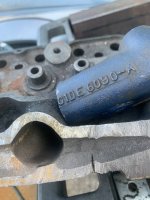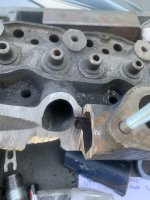Thanks for all the replies. My Main concern would be welding on the manifold and causing cracks. I am not an experienced cast iron welder. The tig would be aluminum bronze for cast iron not silicon bronze. I have both. The bronze requires less heat as you do not have to melt the base metal and flows like solder. I have used it on my 240 6 to make tall rocker covers for roller rockers, but that was sheet metal. Search me in the big six for that story.
Where I would cut the openings is to be decided. I did look in the exhaust ports and saw flashing intrusions and assume the intake has the same.
I am not building a high performance engine. It is my anal retentive personality that makes me do these things. This is for my "new" 1960 falcon which I just got about two months ago. It has a 144 now which I want to replace with a 200 which I presently have, not sure of the shape yet. I also will be replacing the fordomatic with a c4 which I have one but again not sure of the shape. Right now I am just getting the car running with the 144 which I know runs and the transmission has first and reverse as I drove it from one garage to the other.
200 Engine: I will have hardened valve seats, positive valve seals, new valves installed in the head if good. Block, heads and crank at the machine shop now. Plan on installing a Schneider mild cam and forged pistons. I know I do not need forged pistons. I have diamond pistons in my 240 and am happy with them. CR no more than 9.5 or less. With the diamond pistons I can get them made with a specific compression height to get the best quench clearance with out milling the block with more than a clean up and they have floating pins so I can put the pistons on the rods myself. Block will have to be bored but size not determined yet.
Also ARP rod bolts, main and head studs. Yes, over kill I know.
About the car:
Just could not pass up the falcon. No rust or at least I have not found any yet. 3.51 rear gears which I thought was odd but this was an option in 1960 the manual says. Upholstery and interior is good. Seats need new foam. Heck the 13 inch tires are new. Car is a texas car with 57,000 miles on it. No, not perfect but if it was I would not want it. To me its the journey but not a 5year project. At my age I have nothing much to do anyway and I don't play golf!
Car is on the lift and put in new brake and fuel lines, new steering linkage, tightened steering box. The usual stuff. Oh, I do plan on rewiring the car as the wire insulation is brittle and has been fixed in places. I also will replace the generator with 10SI internal regulator alternator. I figure about 3 months to get running with the 144 engine unless it's bad. The 200 engine and C4 next year.
I will see if I can get a head to practice on??????


